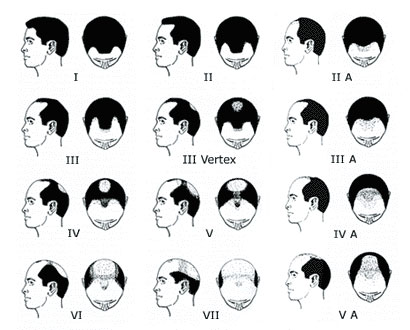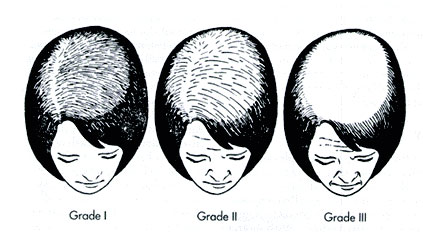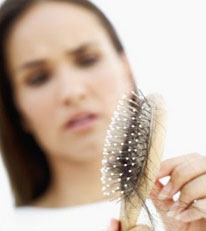The Natural History of Balding
The natural history of balding is simply the way it first presents or appears, the different ways it progresses, and how it affects the different regions of the head. We consider it vital that anyone with common balding become familiar with these concepts. If you can become as conversant as possible with the different balding patterns, and can learn to compare and contrast your own hair loss with these known patterns, you will become a more informed patient. You will ask better questions, understand the answers in more depth, and be more likely to take care of the hair that you do have. Also, if you choose a medical or surgical hair restoration treatment, you will most likely have appropriate expectations, and be more apt to follow the doctor's instructions about post-operative care or taking your medications.
In the beginning, we are born with varying amounts of soft, fine baby hair, which is vellus in nature. As we grow, much of our hair becomes the more robust terminal type. It may change in pigmentation, often becoming darker, and it may acquire a curl or wave, and may become coarser.
After puberty, we see what we call the adolescent hairline. This type of hairline may only persist for a few years, and is characterized by its low, fairly flat spread across the forehead. This looks great on teenagers, but this is rarely found on mature adults, even in their twenties.
As men progress through their twenties, given that there is no balding, the hairline assumes the "mature" look, with slight frontal-temporal recessions, which impart a concave appearance to the hair line on each side, with a lower peak in the middle. This is analogous to the number "II" Classification on the Norwood scale (fig. 3). This is the most well known of several systems for classifying degrees of baldness, and was developed by Dr. O'Tar Norwood. This is a very useful scale for identifying one's own current degree of hair loss in a way that is acknowledged and understood by physicians in the field of hair loss treatment.
This "mature" hairline is not considered balding; the Norwood III is considered the first evidence of balding in androgenetic alopecia (male pattern baldness). In studying the Norwood charts, we see that usually the most advanced balding is known as a class VII, and that there are also Type "A" variants in which the forelock in the middle tends to recede along with the frontotemporal areas, and in which there is less overt crown loss than in the regular III, IV, and V patterns.

Figure 3
So there may be front-to-back hair loss, or hair loss beginning in front and at the crown simultaneously, or sometimes isolated vertex or crown loss (the "bald spot"). These patterns are often overlapping and not as clear-cut as in the drawings on the chart, but they are an adequate and useful guide. It is important to understand that a person may be a III at age 25, but have progressed to a V or VI by age 35. Anyone considering surgical hair restoration needs to understand the unpredictable nature of the balding process; if further loss is not planned for, then what may be a nice cosmetic effect at one age can become a cosmetic nightmare ten years down the road. We will devote an entire, later section to just this kind of strategic planning.
A word about women's hair loss: women can experience a Norwood type of hair loss pattern. More often, however, they experience a relative sparing and preservation of the frontal hairline, but have diffuse thinning on the top of the scalp. There is also a classification system for women known as the Ludwig Classification (figure 4).

Figure 4
Sometimes women are candidates for surgical hair restoration due to balding, and at times have lost hair due to other cosmetic procedures, like face-lifting. This hair loss is often around the hairline or ears, and can be remedied. Women may also experience "traction alopecia", which is caused by the chronic tugging force of tight braids or pigtails. This type of loss is also amenable to transplantation.
We have attempted here to stress the relative unpredictability of "pattern" baldness. This must be reemphasized. Often, young men seek hair transplantation and have desires or illusions about how they would like to appear. These may or may not be feasible. Certainly, when one is 25, it may be hard to care about one's appearance at 45, but this must be factored into the equation. The recent memory of the low, adolescent hairline burns brightly in the mind of a young man, but a really good hair transplant procedure should always give the patient results that can be "worn" for a lifetime, and always appear appropriate for that individual's age and head shape. This is where the attention of an experienced, well-trained, aesthetically sensitive hair restoration surgeon makes all the difference in the world.
e. This re-tightening or re-bonding must be done about every month, usually for a fee. Incidentally, many hair restoration surgeons feel that prolonged wearing of wigs and systems may accelerate the process of hair loss, probably through a variety of mechanisms.
Many men chose to use a hairpiece rather than undergoing surgical hair transplantation because of the latter's cost. However, when we calculate a lifetime of periodic purchases of hairpieces (they do wear out!), the need to have two or more pieces available, the periodic maintenance, and, for many systems, monthly maintenance and/or re-tightening charges that may range from $100 to over $500, the cost obviously adds up. Hair transplantation, on the other hand, provides a permanent growth of natural hair from the patient's own head, and this may require only one procedure for a lifetime. Some men have such advanced baldness and such limited "donor" hair, that a hairpiece is a good option. Only a consultation with a physician specializing in hair restoration can help the balding patient make a truly educated decision.
Our customer service representatives are available 24 hours a day, from Monday to Sunday. Contact Us



The Natural History of Balding
Surgical Treatments for Hair Loss
...> more info ...






